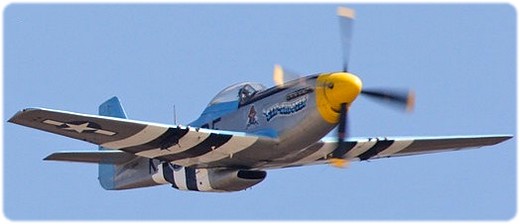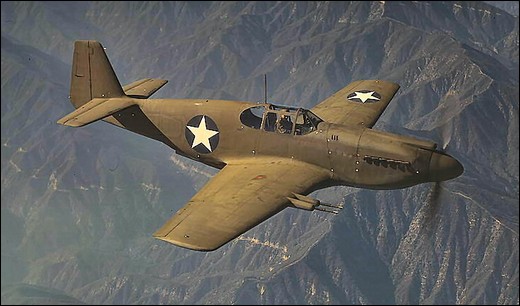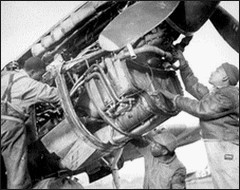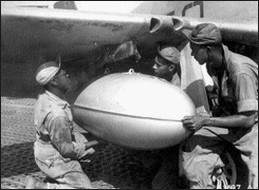 |
North American P-51 Mustang
P-51 Mustang is one of the true classics of World War 2. Faster than any other fighter, beautiful looks and with an incredible range. Its primary task in Europe was to escort and defend allied bombers on their way to central Germany and all the way back to England. Before the Mustang entered the stage, the escorting fighters had had to abort and head back to base to refuel almost as soon as they reached the continent, abandoning the bomber crews as they needed their help the most.
 |
|
| Visible under the wings of these P-51D are the drop tanks that made it possible to escort bombers to the very heart of Germany. When the tanks had been emptied or if enemy fighters were encountered, they were jettisoned and the pilot would switch to normal fuel supply. The Mustang farthest away is a P-51C. |
[ Top of page ]
History
When war broke out in 1939, the British were in serious need of material, not the least fighters. There were many aircraft factories in England and although they were assembling airframes around the clock, it simply wasn't enough. A request was made to the Americans for buying the Curtiss P-40. But Curtiss too had their order books full, and the British now turned to North American and asked them to build the P-40. By then North American were developing their own fighter model, and suggested that one instead, and the British agreed.
 |
|
| The first Mustang, P-51A, designed by Raymond Rice and Edgar Schmued, during a test flight in America. Its appearance differs from the famous D-model, notably by being "high-back" (the back of the fuselage is connected to the top of the hood instead of going underneath it, "low-back") |
The maiden flight was carried out by test pilot Vance Breese in October 1940, only 178 days after the order was put. The aircraft - now going by the name Mustang - was more modern and better than earlier allied fighters, but the Allison-engine was a disappointment at higher altitudes. When this turned out to be an unsolvable problem, the Allison was replaced with a British 1,695 hp Rolls-Royce Merlin, made under license in the USA by Packard. P-51 Mustang had now become a superior fighter in every aspect, and was put to active duty in April 1941.
 |
 |
| Ground crew from the famous "Tuskegee Airmen" division doing repair work and attaching a drop tank to a Mustang. | |
At the time World War 2 was finally coming to an end, four Mustangs made emergency landings in Skåne, Sweden. These were taken over and became the first of the type in the Swedish air force. Soon fifty more P-51D were ordered and delivered in April 1945. All-in-all, 161 Mustangs had been acquired by 1948. About a dozen of them were converted to recognisance aircraft, with the designation S 26. The last Swedish military Mustang was discharged in 1954.
 |
| Two nicely checker painted P-51D at Berlin Air Show 2005. |
A little more than a hundred of the 16,000 once manufactured P-51 Mustangs are today considered airworthy at different locations around the world. They were made in many versions (from A to M, the later models only as one or two prototypes) but it is the P-51D that is the classic - and in my opinion the best looking - Mustang, with its low-back and bubble canopy.
[ Top of page ]
Video
| P-51D Mustang piloted by Bertil Gerhardt at an air show in Ljungbyhed, May 31, 2008. This Mustang is owned by Biltema and is based at Ängelholm airport, Sweden. | |
| Another P-51D, this time from a display in Norway 1997. | |
[ Top of page ]